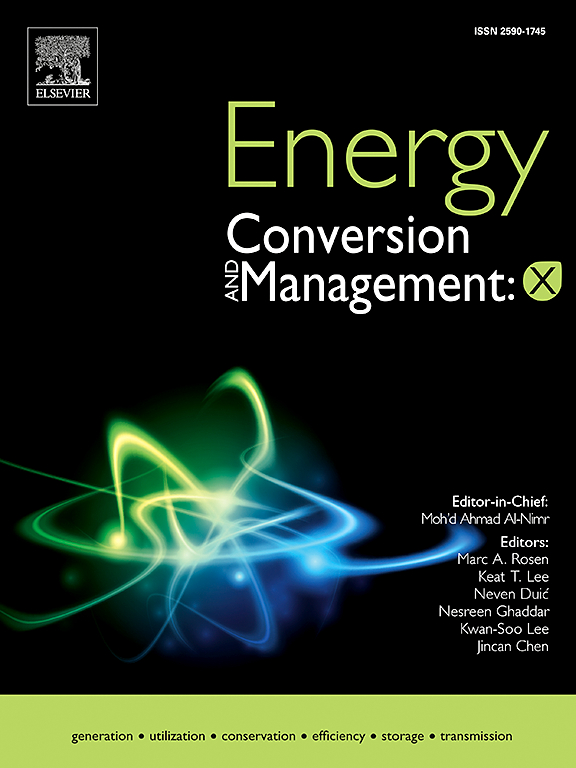Experimental investigation of graphene-based nanofluid enhanced photovoltaic/thermal system: Energy and exergy analysis
IF 7.6
Q1 ENERGY & FUELS
引用次数: 0
Abstract
The performance of photovoltaic (PV) modules is significantly influenced by the operating temperature, the higher temperature the lower module efficiency. The primary objective of this study is to design, fabricate, and evaluate a photovoltaic/thermal (PV/T) system equipped with a finned-serpentine channel, utilizing water and graphene nanoparticle (GnP/water) with 0.25 %, 0.5 %, 0.75 %, and 1 % concentrations as coolants at Reynold number equals to 1250. The PV/T system’s performance was assessed by analyzing its energy and exergy, focusing on electrical, thermal, and exergy efficiencies. The results revealed that the PV/T system achieved electrical efficiency increments of 4.5 %, 7.6 %, 9.8 %, 13.9 %, and 15.5 % with water and NFs with 0.25 %, 0.5 %, 0.75 %, and 1 % concentrations, respectively. Furthermore, the thermal efficiency was improved by 1.4 %, 1.8 %, 2.3 %, and 2.5 % for the increased nanofluids (NFs) concentrations. The exergy efficiencies exhibited significant gains, with electrical and thermal exergy efficiencies improving by up to 15.5 % and 31.6 %, respectively, compared to water. These results highlight the substantial cooling potential of NFs to enhance the PV module’s performance, which positively improves PV-related applications.
石墨烯基纳米流体增强型光伏/热系统的实验研究:能量和放能分析
光伏(PV)组件的性能受工作温度的影响较大,温度越高组件效率越低。本研究的主要目标是设计、制造和评估配备有鳍状蛇形通道的光伏/热(PV/T)系统,利用0.25%、0.5%、0.75%和1%浓度的水和石墨烯纳米颗粒(GnP/water)作为雷诺数等于1250的冷却剂。PV/T系统的性能是通过分析其能量和火用来评估的,重点是电、热和火用效率。结果表明,当水和NFs浓度分别为0.25%、0.5%、0.75%和1%时,PV/T系统的电效率分别提高了4.5%、7.6%、9.8%、13.9%和15.5%。此外,随着纳米流体(NFs)浓度的增加,热效率分别提高了1.4%、1.8%、2.3%和2.5%。与水相比,电用和热用效率分别提高了15.5%和31.6%。这些结果突出了NFs在提高光伏组件性能方面的巨大冷却潜力,从而积极改善了光伏相关应用。
本文章由计算机程序翻译,如有差异,请以英文原文为准。
求助全文
约1分钟内获得全文
求助全文
来源期刊

Energy Conversion and Management-X
Multiple-
CiteScore
8.80
自引率
3.20%
发文量
180
审稿时长
58 days
期刊介绍:
Energy Conversion and Management: X is the open access extension of the reputable journal Energy Conversion and Management, serving as a platform for interdisciplinary research on a wide array of critical energy subjects. The journal is dedicated to publishing original contributions and in-depth technical review articles that present groundbreaking research on topics spanning energy generation, utilization, conversion, storage, transmission, conservation, management, and sustainability.
The scope of Energy Conversion and Management: X encompasses various forms of energy, including mechanical, thermal, nuclear, chemical, electromagnetic, magnetic, and electric energy. It addresses all known energy resources, highlighting both conventional sources like fossil fuels and nuclear power, as well as renewable resources such as solar, biomass, hydro, wind, geothermal, and ocean energy.
 求助内容:
求助内容: 应助结果提醒方式:
应助结果提醒方式:


